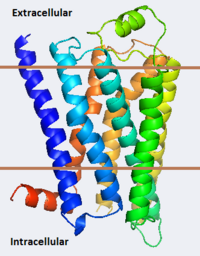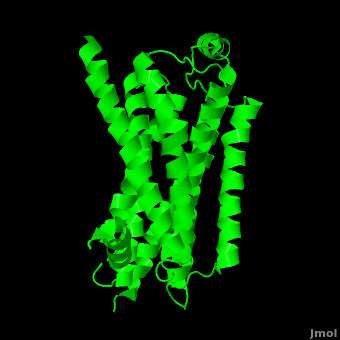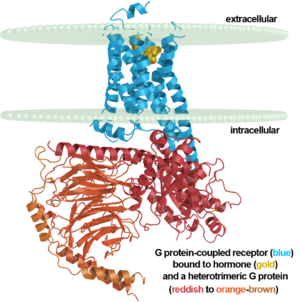Beta-2 Adrenergic Receptor
From Proteopedia
Beta-2 Adrenergic Receptors (B2ARs) are a type of G Protein-Coupled Receptor (GPCR). GPCRs are the largest family of integral membrane proteins in the human body with over 1000 unique Isoforms. B2AR is activated by hormone ligands like adrenaline (epinephrine) and noradrenaline and plays a critical role in cardiovascular and pulmonary physiology. Binding of adrenaline by B2AR causes a sympathetic nervous system response like the well-known “fight or flight response”, resulting in an increased heart rate, pupil dilation, rapid energy mobilization and diversion of blood to skeletal muscle. More precisely, upon binding a ligand, B2AR activates Adenylyl cyclase through interaction with B2ARs C-terminus. Adenylyl cyclase subsequently converts ATP into cAMP, which functions as a downstream signaling molecule activating effectors like cAMP-dependent protein kinases, resulting in various bodily responses.[1]
B2AR and AutismDuring embryo development, Beta adrenergic receptors are involved in fetal growth, tissue differentiation and axonal outgrowth. During fetus development, B2AR transcription is progressively downregulated and undergoes desensitization. These steps are essential homeostatic mechanisms to prevent cells from being overly stimulated and maintaining the correct sympathetic to parasympathetic tone. This sympathetic-parasympathetic tone determines the point at which the sympathetic nervous system (flight or fight) overrides the parasympathetic nervous system (responsible for normal cardiovascular homeostasis). The B2AR downregulation and desensitization steps are first established during prenatal development during the first and second trimester.[1] Interestingly, overstimulation of B2ARs during critical periods of prenatal development can cause a permanent increase in the sympathetic to parasympathetic tone. Overstimulation of this type is caused by stress in the mother for reasons ranging from infections to hardships like natural disasters. Since children with autism typically have an elevated sympathetic tone and elevated B2AR stimulation during development causes an elevated sympathetic tone, this partly explains why children of mothers who survive natural disasters during pregnancy have a higher incidence of Autism Spectrum Disorders (ASDs).[1] Fevers and the Locus CoeruleusAs an aside, stress during prenatal development has also been proven to impact locus coeruelus (LC) development. Nearly all adrenaline in the brain is produced and transported by neurons in the Locus Coeruleous, a small area of the brain. The locus coeruleus-Noradrenergic System (LC-NA) plays a crucial role in virtually all aspects of behavioral adaptations and performance of cognitive regions of the brain commonly affected in ASDs.[2] Critical enzymes for proper LC can be downregulated by aberrant epigenetic modifications caused by prenatal stress. One well known example of this is hypomethylation of the Crh gene. When methylated, the Crh promotor is bound by the transcriptional repressor, MeCP2. Aberrant epigenetic modifications caused by prenatal stress can cause Crh promoters to be under methylated, preventing MeCp2 binding and subsequently causing overexpression of the Crh gene. Overexpression of the Crh gene is a trademark of Rett Syndrome, a well known neurodevelopmental disorder Interestingly, when some autism patients have a fever, the LC-NA system dysfunction abates resulting in reduced autistic behaviors. This implies that the underlying neural networks mediating the LC-NA system are still functional, and offers hope for partial reversal of ASDs through pharmaceutical intervention.[2] Structure of B2ARsAs a family, GPCRs are renowned for their structure solution difficulty. In this model, Beta2-Adrenergic Receptor (B2AR) – T4 Lysozyme fusion was developed to allow for structure solution. Fortunately, the lysozyme portion of the structure does not appear to impact the structure of the B2AR. The structure of B2AR is very similar to the GPCR Rhodopsin, which is a photoreceptor in the retina which allows the perception of light. B2AR is a transmembrane protein with 7 transmembrane helices and an 8th helix which runs parallel to the cytoplasmic face of the membrane.[3] Helices 2,5,6 and 7 of B2AR have kinks caused by prolines at conserved places, which are important for activation of G protein effectors. The extracellular regions on all GPCRs dictate the ligand specificity of GPCRs. The partial inverse agonist, Carazolol, binds to the receptor binding pocket of B2AR, reducing the basal activity of the receptor. This interaction involves residues Tyr 199, Ser 203, Ser 207, Phe 193, Ser 204, Ser 293, Phe 290, Tyr 308, Phe 289, Asn 312, Tyr 316, Trp 286, Trp 109 and Asp 113. Carazolol occupies a similar position as the rhodopsin inverse agonist, retinal. Carazolol does not act with the so called “toggle switch” on helix 6, but does interact with Phe 290, causing Trp 286 to assume an inactive rotameric state, effectively inhibiting B2AR activity.[4] A conserved DRY motif (residues 130-132) is present in all GPCRs.[5] In rhodopsin, the Arginine in this motif forms a salt bridge with a glutamate, an interaction that maintains rhodopsin in its inactive state until it is exposed to light. In B2AR, Arg 131 does not interact with Glu 268, which helps explain why B2AR has basal activity. Interestingly, Rhodopsin has no basil activity, a feature that is critical for vision.[6] Pharmaceutical ImplicationsAlthough activation of B2AR upon ligand binding is not fully understood, a recently solved structure of Beta 1 Adrenergic Receptors offers clues. Agonists of B1ARs disrupt the interaction (2y02) between Val 172 and Ser 215, eliminating a key interaction between helices four and five. Since mutation to Val 172 is known to reduce basal activity, it is likely that the agonists interference of Val 172 has a similar affect.[7] The class of pharmaceutical drugs known as the “beta blockers” are antagonists of B2AR. They diminish the effects of adrenaline, slowing the heart rhythm and reducing blood pressure. B2AR Agonists serve a completely different purpose. These molecules which mimic native ligands of B2AR cause smooth muscle relaxation, bronchial passage dilation, vasodilation and rapid release of insulin. These compounds are used to treat asthma, and include the well-known Albuterol and Terbutaline.[8] See also Beta-2 receptors agonists.
|
| ||||||||||
Contents |
3D structures of beta-2 adrenergic receptor
β2 adrenergic receptor binding a hormone analog |
| |||||||||||
Nobel Prize Related to the Structures
Robert J. Lefkowitz and Brian K. Kobilka share the 2012 Nobel Prize in Chemistry for work on GPCRs that includes solving the first structures of a ligand-activated GPCR (2r4r, 2r4s, & 2rh1 in 2007)[1][2][3] and the first activated GPCR in complex with its G protein (3sn6 in 2011)[4][5][6][7]. A detailed description of the laureates' body of work on this class of receptors with images is here.
References
- ↑ 1.0 1.1 1.2 Witter FR, Zimmerman AW, Reichmann JP, Connors SL. In utero beta 2 adrenergic agonist exposure and adverse neurophysiologic and behavioral outcomes. Am J Obstet Gynecol. 2009 Dec;201(6):553-9. PMID:19961985 doi:10.1016/j.ajog.2009.07.010
- ↑ 2.0 2.1 Mehler MF, Purpura DP. Autism, fever, epigenetics and the locus coeruleus. Brain Res Rev. 2009 Mar;59(2):388-92. Epub 2008 Nov 24. PMID:19059284 doi:10.1016/j.brainresrev.2008.11.001
- ↑ Rasmussen SG, Choi HJ, Rosenbaum DM, Kobilka TS, Thian FS, Edwards PC, Burghammer M, Ratnala VR, Sanishvili R, Fischetti RF, Schertler GF, Weis WI, Kobilka BK. Crystal structure of the human beta2 adrenergic G-protein-coupled receptor. Nature. 2007 Nov 15;450(7168):383-7. Epub 2007 Oct 21. PMID:17952055 doi:10.1038/nature06325
- ↑ Cherezov V, Rosenbaum DM, Hanson MA, Rasmussen SG, Thian FS, Kobilka TS, Choi HJ, Kuhn P, Weis WI, Kobilka BK, Stevens RC. High-resolution crystal structure of an engineered human beta2-adrenergic G protein-coupled receptor. Science. 2007 Nov 23;318(5854):1258-65. Epub 2007 Oct 25. PMID:17962520
- ↑ Hanson MA, Cherezov V, Griffith MT, Roth CB, Jaakola VP, Chien EY, Velasquez J, Kuhn P, Stevens RC. A specific cholesterol binding site is established by the 2.8 A structure of the human beta2-adrenergic receptor. Structure. 2008 Jun;16(6):897-905. PMID:18547522 doi:10.1016/j.str.2008.05.001
- ↑ Scheerer P, Park JH, Hildebrand PW, Kim YJ, Krauss N, Choe HW, Hofmann KP, Ernst OP. Crystal structure of opsin in its G-protein-interacting conformation. Nature. 2008 Sep 25;455(7212):497-502. PMID:18818650 doi:10.1038/nature07330
- ↑ Warne T, Moukhametzianov R, Baker JG, Nehme R, Edwards PC, Leslie AG, Schertler GF, Tate CG. The structural basis for agonist and partial agonist action on a beta(1)-adrenergic receptor. Nature. 2011 Jan 13;469(7329):241-4. PMID:21228877 doi:10.1038/nature09746
- ↑ Cruickshank JM. Beta blockers in hypertension. Lancet. 2010 Aug 7;376(9739):415; author reply 415-6. PMID:20692524 doi:10.1016/S0140-6736(10)61217-2
See Also
- G protein-coupled receptor
- Receptor
- Transmembrane (cell surface) receptors
- Adrenergic receptor
- The Madison West High School 2008 SMART Team's Page on the β-2 adrenergic receptor
- Nobel Prizes for 3D Molecular Structure
- Highest impact structures of all time
- G proteins
- Rhodopsin
- GTP-binding protein
- Pharmaceutical Drugs
- Membrane proteins
- Hormone
External Resources
- Robert J. Lefkowitz and Brian K. Kobilka share the 2012 Nobel Prize in Chemistry for work on GPCRs that includes solving the first structures of a ligand-activated GPCR (2007) and the first activated GPCR in complex with its G protein (2011). A detailed description of the laureates' body of work on this class of receptors with images is here.
- The April 2008 RCSB PDB Molecule of the Month feature on Adrenergic Receptors by David S. Goodsell is 10.2210/rcsb_pdb/mom_2008_4.
Page Development
This article was initially developed based on lectures given in Chemistry 543 by Prof. Clarence E. Schutt at Princeton University.
Proteopedia Page Contributors and Editors (what is this?)
Wayne Decatur, David Canner, Alexander Berchansky, Dotan Shaniv, Joel L. Sussman, Michal Harel



